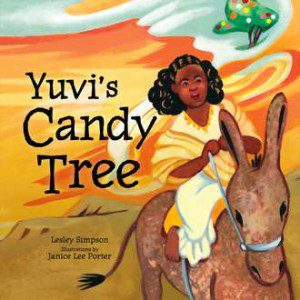According the the Torah, we are obligated to teach our children about the Exodus. But try using a picture book to fulfill this mitzvah, and you’ll find that half of the children’s Passover books are about fluffy (or not-so-fluffy) matzoh balls, while the other half talk about throwing babies into the Nile river. For parents of young children it’s hard to find a book that’s substantive enough to bring the Exodus to life, but not so much that it induces nightmares.
 Nachshon Who Was Afraid to Swim stands out as an exception – a wonderful book for helping our children imagine making the frightening journey by foot to the Promised Land. Lesley Simpson (surely you know her from The Shabbat Box) has given us another option – Yuvi’s Candy Tree – a picture book based on the true story of one child’s journey from Ethiopia to Israel. While it’s not technically a Passover book, it really (sort of) is. You’ll see what I mean when you read the interview, and again when you read the book (which you will absolutely want to buy.)
Nachshon Who Was Afraid to Swim stands out as an exception – a wonderful book for helping our children imagine making the frightening journey by foot to the Promised Land. Lesley Simpson (surely you know her from The Shabbat Box) has given us another option – Yuvi’s Candy Tree – a picture book based on the true story of one child’s journey from Ethiopia to Israel. While it’s not technically a Passover book, it really (sort of) is. You’ll see what I mean when you read the interview, and again when you read the book (which you will absolutely want to buy.)
I’d summarize the book for you, but Publisher’s Weekly did such a good job I’m lifting quoting their review instead.
“Five-year-old Yuvi narrates her tense exodus from Ethiopia to Israel in this story based on the real-life journey made by Yuvi Tashome, who was among thousands of Ethiopian Jews relocated, secretly at first, to Israel during the 1980s and ’90s as part of Operations Moses and Solomon. Simpson (The Purim Surprise) and Porter (Blackberry Stew) convey the hardships faced by Yuvi, her relatives, and the other refugees (they are robbed three times), while providing reassurance in the form of references to the group’s unshakable faith in their escape…..” (Publisher’s Weekly, February 7)
I asked Simpson what inspired her to write a children’s story about a young girl’s difficult, and sometimes dangerous, life story.
I met Yuvi in 2009 when she was in Toronto. She was this exceptional woman and when she told me her story, it got under my skin and lived inside me. She had a very acute memory of the experience, even though she was only five years old when it happened. She remembered the woosh of the wind, and this constant thirst, and looking up at the moon and the stars. As I heard her talking, I felt as I were being handed a story and it was my obligation to write it down.
Simpson explains how she came to think of Yuvi’s story as a Passover book.
When I met Yuvi, I had just hosted my very first seder with my husband. I thought, “How many of us have ever met someone who went through a real exodus?” I felt like the hagaddah was coming to life in front of me..If you were trying to contemplate what an Exodus might look like today, this would be quite an extraordinary way to do that. (Like the Israelite slaves)…all the while she thought of Jerusalem as a place where wishes would come true.
Like Deborah Boden Cohen, the author of Nachshon, Simpson adopts a child’s point of view to take a potentially terrifying story and make it suitable for children.
Yuvi experienced this incredibly dangerous journey. I couldn’t include all of the death and trauma in the book, of course -it’s estimated that about half of the Ethiopian Jews died on that Exodus, they were attacked, they were raped, they were buried on the way…For an adult, it was a terribly traumatic experience, but because she was five at the time, traveling with her grandmother, in her memory it was also a playful experience.
She captures this childlike quality in the simple language of the narrative. We get glimpses of Yuvi’s playfulness as she helps outwit robbers and fantasizes about the miracles she may encounter in Jerusalem.
When Yuvi told me her story, she remembered she had only had candy once. Her father had bought her a hard candy – maybe a peppermint – and she loved it. She had only had candy once! In her life! Candy is like an international language. So when she imagined Israel, she dreamed that candy would grow on trees.
I haven’t read Yuvi to my own daughters yet – I’m considering saving it until the seder night. But I’m looking forward to sharing the story with them. Admittedly, they saw the cover and expressed an immediate dislike of the illustrations (which I also found disappointing) but I think the text, and the amazing story behind the text, will be more than enough to win them over. And besides, who can resist a story about a Candy Tree?

